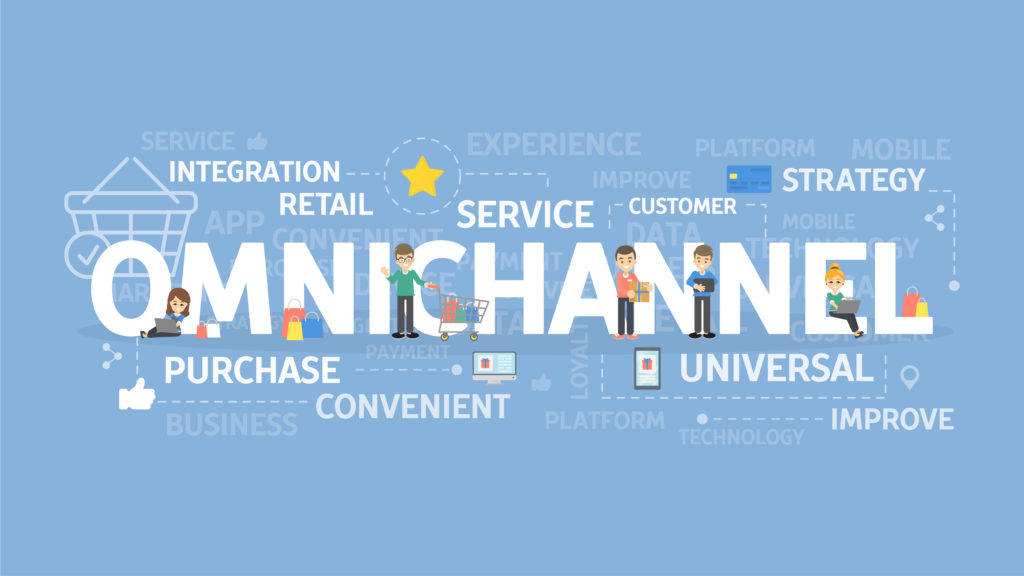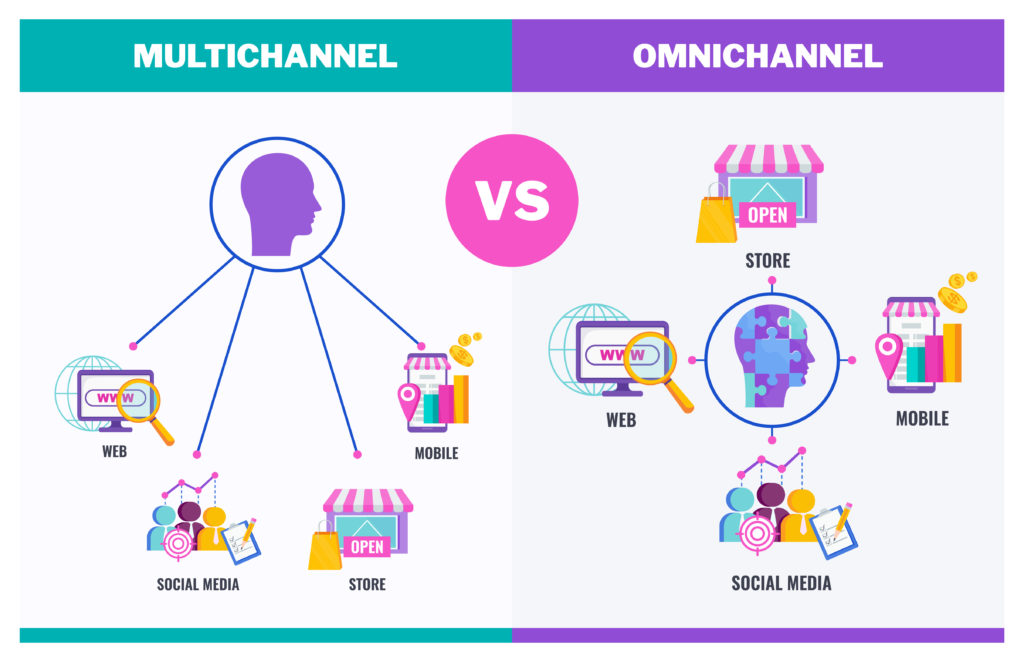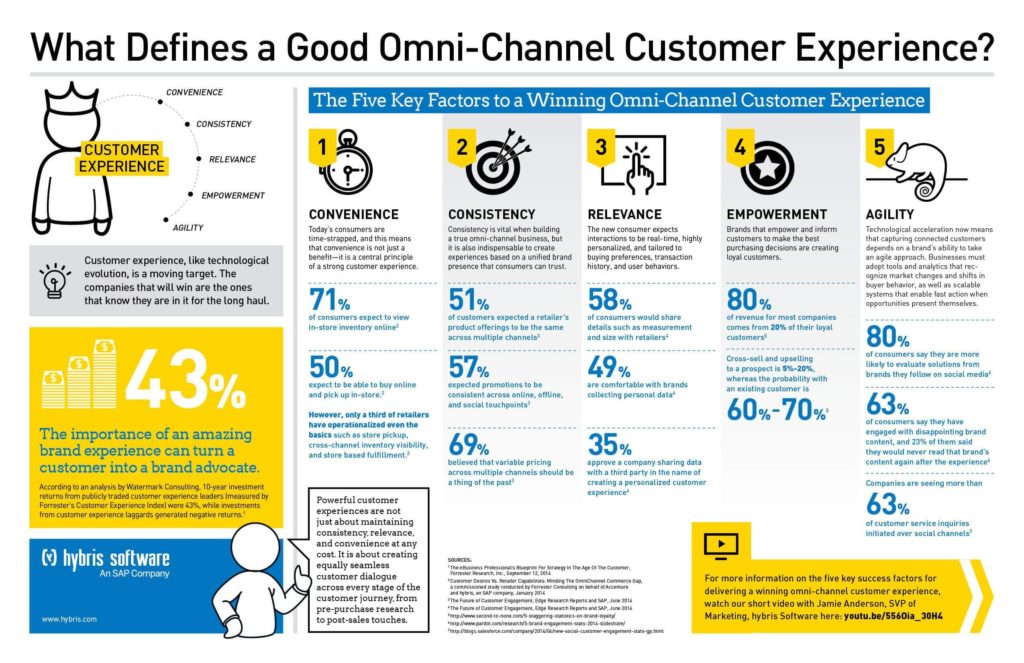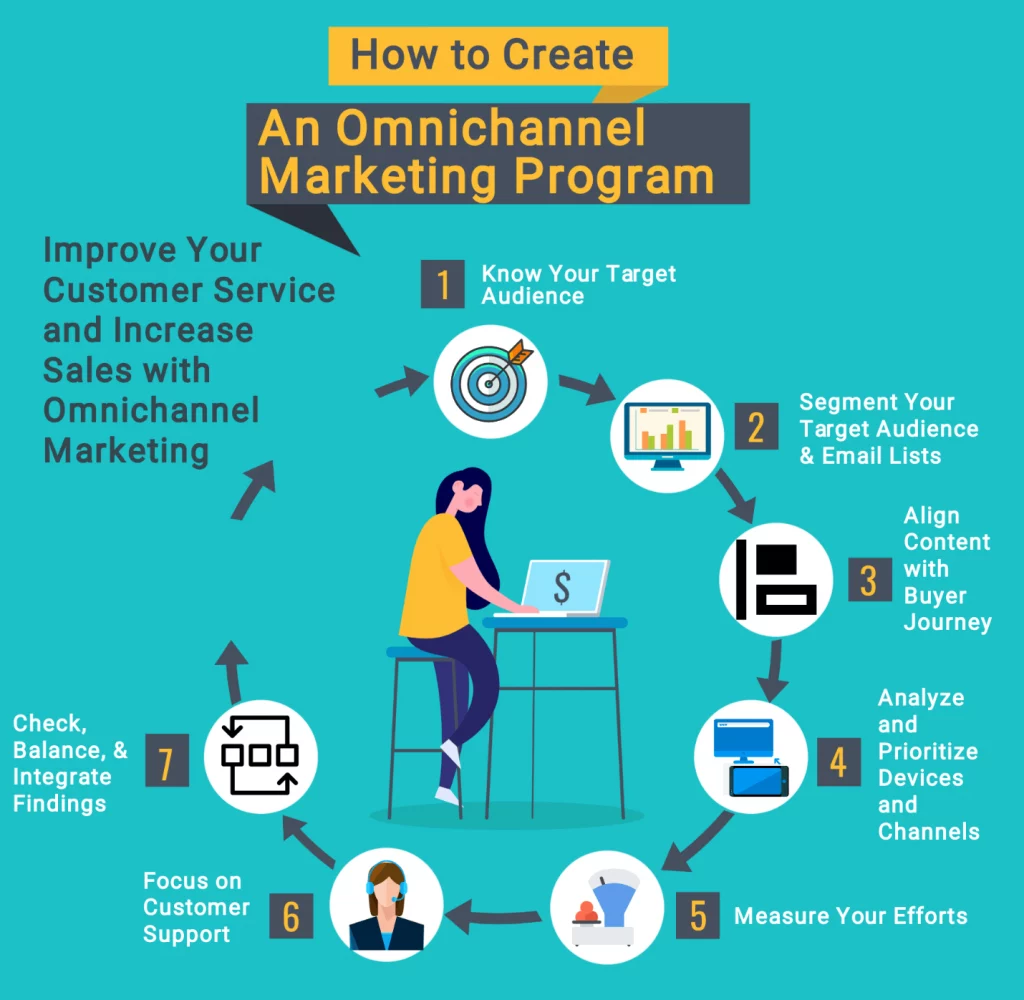
WHAT IS OMNICHANNEL MARKETING
Omnichannel marketing is a way of marketing that is focused on the customer and uses multiple platforms to create a smooth and uniform experience for the customer. This means that customers can connect with a brand in any way they want, and their experience will be the same no matter their choice.
In this case, the word “media” refers to how a brand can contact its people. Some of these outlets are online, like websites, social media, and email. Others are offline, like shops, call centers for customer service, and print ads.
When done right, omnichannel marketing can help businesses in a number of ways, such as:
- Customers are more likely to be happy with their overall experience if it is the same across all channels. Customers like being able to connect with a brand through the channels they prefer, and they are more likely to be happy with their overall experience if it is the same across all channels.
- Increased brand recognition: Customers can be reached through various platforms with omnichannel marketing, which can help raise brand awareness.
- Sales can go up with omnichannel marketing because it makes it easy for customers to buy goods or services.
Some of the things that help make a customer’s journey unique are:
- A constant brand voice: The brand’s voice should be the same across all channels so customers know what to expect no matter how they connect with the brand.
- Customers should be able to have unique experiences with the brand so that they feel like they are being treated as people.
- Analysis all the time: The brand should always look at the customer trip to see where it can make improvements.
Four Details to Keep in mind when doing an Omnichannel Marketing Campaign
Omnichannel marketing is a way to reach people that uses more than one channel. This can be done through online channels like social media, email, and websites, as well as physical channels like shops, call centers for customer service, and print ads.
The goal of multichannel marketing is to make sure that customers have a smooth experience with a brand no matter what medium they use to do so. This means that the brand’s message, logos, and deals should be the same across all platforms.
There are many good things about omnichannel marketing, such as:
Customers are more likely to be happy with their overall experience if it is the same across all channels. Customers like connecting with a brand through the channels they prefer, and they are more likely to be happy with their overall experience if it is the same across all channels.
Increased brand recognition: Customers can be reached through various platforms with omnichannel marketing, which can help raise brand awareness.
Sales can go up with omnichannel marketing because it makes it easy for customers to buy goods or services.
Here are a few ways to get started with omnichannel marketing:
Identify your target audience: Who do you want your mobile marketing strategy to reach? Once you know who you want to reach, you can make sure that your message and deals fit their needs and hobbies.
Choose the right way to reach them: Not every station is the same. Some outlets are better than others at reaching certain groups. For example, if you’re trying to reach teenagers, you might want to focus on Instagram and TikTok.
Make your messages consistent: Your message should be the same on every site. This means that all outlets should use the same style, tone, and images for the brand.
Follow your progress: Tracking your results is important so you can see what’s working and what’s not. This will help you improve your digital marketing strategy over time.
Omnichannel marketing can be hard to do, but it can be very successful if it’s done right. Following these steps, you can make an omnichannel marketing plan to help you reach your target audience, raise brand knowledge, and boost sales.
Slow and steady wins the race.
Effective multichannel marketing does take time and consistency to develop. Since you are still learning the ropes, it is best to start off by acquiring experience gradually rather than attempting to be active on all channels at once. Starting with one or two social media platforms can help you concentrate and develop knowledge in those fields.
You may progressively add more channels to broaden your reach after you feel at ease and have gained some expertise on those basic ones. By taking modest steps, you may sustain your development without overwhelming yourself or using up all of your resources.
Maintaining contact with those who respond to your message on all social media platforms is essential. This entails actively connecting with them and replying to their posts, as opposed to ignoring certain sites. Maintaining a consistent level of interaction shows your dedication to provide top-notch customer service while also fostering connections and trust.
You may successfully deploy an omnichannel marketing strategy to increase your reach and impact by gradually growing your presence and maintaining engagement across many platforms.
Connect with their heart, not their money!
It’s crucial to put emotional connections with consumers first when implementing omnichannel marketing instead of only concentrating on business transactions. While turning a profit is a key component of doing a company, it’s also critical to go above and beyond and make sure that your clients have a satisfying and memorable experience.
It is advantageous to tell a narrative, provide instances of successful shop growth, and solve people’s concerns rather than just uploading product photographs with the purpose of boosting sales. You may foster trust, loyalty, and deep connections with your audience by offering informative material and getting to know them better.
Consumers who are satisfied with your product or service are likelier to remain loyal and promote your business. You may make a lasting impression and develop a loyal client base by valuing their experience and relating to them truthfully.
It’s important to remember that embracing the human side of marketing and caring about your consumers’ needs and wants will ultimately be more productive than concentrating just on making money. You can help your company develop and succeed sustainably by creating relationships and providing value.
Keep your message but change the words.
When it comes to SEO and content optimization, using boilerplate content, which entails duplicating and pasting the same content across multiple web pages, can have negative effects. Search engines such as Google and social media platforms view boilerplate content as repetitious and unoriginal, which can result in a drop in rankings and visibility.
The semantic cacophony created by boilerplate content makes it difficult for search engines to determine the unique value of each page. It can confound search algorithms and reduce your website’s visibility in search results.
To ensure that your content is effective and well-received by search engines, it is essential to maintain messaging and branding consistency while modifying semantics. This requires discovering your brand’s voice and expressing it in a unique and genuine manner on each page.
By avoiding repetitive content and focusing on creating original, valuable, and engaging content, you can improve your SEO efforts and increase your website’s visibility in search engine results. This method not only satisfies search engine requirements, but also improves the user experience for your audience, resulting in increased organic traffic and user engagement.
Include a Call to Action on your Omni-Channel Marketing
Utilizing a call to action (CTA) is an effective way to measure the effectiveness of your marketing campaigns and encourage the audience to take the desired action. CTAs encourage specific user actions, such as making a purchase, subscribing to a publication, or obtaining a resource.
However, it is vital to avoid overusing CTAs in your messages. Oversaturating your audience with excessive calls to action may result in a poor user experience. It is essential to strike the right balance and strategically position CTAs where they will be most effective.
In addition, it is essential to ensure that your CTAs are unambiguous and do not confuse your consumers. They should provide precise direction and make it simple for users to comprehend the desired action.
An omnichannel campaign provides a variety of engagement opportunities and possibilities. By incorporating deliberate CTAs and other strategies into your omnichannel strategy, you can effectively drive customer actions, increase conversions, and attain your marketing objectives.
Reading articles and staying informed about the development and growth of your small business is a valuable practice that can help you refine your marketing strategies and remain ahead of the competition.

source
What are the benefits of using Omnichannel Marketing?
An average individual receives between six (6) thousand to ten (10) thousand ads daily. This gives the consumer a robust power to select the brand that is better:
Provide superior service
Solve their needs and problems
Add value to their lives
Sell quality products at the right price
This is an impressive number of daily ads, but the question should remain: How are you planning to be different from the rest?
Using omnichannel gives you an advantage over your competitors. Although, of course, doing omnichannel marketing takes time and planning, the outcomes are remarkable. Here are some examples of the impact of omnichannel marketing (v12data.com):
- The purchase rate increased by 287% than those using a single-channel campaign. (Omnisend, 2020)
- Omnichannel campaigns that involved SMS at some point in the process were 47.7% more likely to end in conversion. (Omnisend, 2020)
- Purchase frequency is 250% higher on omnichannel vs. single-channel, and the average order value is 13% more per order on omnichannel vs. single channel. (Omnisend, 2020)
- Customer retention rates are 90% higher for omnichannel vs. single channel. (Omnisend, 2020)
- 98% of Americans switch between devices on the same day. (Google Research)
- Fifteen years ago, the average consumer typically used two touchpoints when buying an item, and only 7% regularly used more than four. Today consumers use an average of almost six touchpoints, with nearly 50% regularly using more than four. (Marketing Week)
- Over 35% of customers expect to be able to contact the same customer service representative on any channel. (Zendesk)
- Companies with robust omnichannel customer engagement retain 89% of their customers, compared to 33% for companies with weak omnichannel customer engagement. (Aberdeen Group)
- 77% of strong omnichannel companies store customer data across channels, compared to 48% for weak omnichannel companies. (Aberdeen Group)
- 61% of customers have not easily switched from one channel to another when interacting with customer service. (Aspect)
- Customers’ orders placed online and picked up at brick-and-mortar stores grew 208% during the pandemic. (Adobe Analytics, 2020)
- Data collected by Think With Google indicated that omnichannel strategies help generate around 80 percent of the in-store visits by customers. Furthermore, 74 percent of customers do online research before visiting a physical store. (Think With Google, 2021)
- 64% of marketers cite a lack of resources and investment as their top barrier to omnichannel marketing. (The CMO Club)
- 90% of customers expect consistent interactions across channels. (SDL)
- 71% of shoppers who use smartphones for research in-store say that it’s become an essential part of the experience. (Google)
- Omnichannel shoppers have a 30% higher lifetime value than those who shop using only one channel. (Google)
- Companies with robust omnichannel customer engagement see a 9.5% year-over-year increase in annual revenue, compared to 3.4% for weak omnichannel companies. Similarly, strong omnichannel companies see a 7.5% year-over-year decrease in cost per contact, compared to a 0.2% year-over-year decrease for vulnerable companies. (Aberdeen Group)
- Of those companies, Aberdeen Group was identified as the top performer in omnichannel strategy; 85% conduct regular training of customer care agents in handling omnichannel communications, and 77% store customer contact data across multiple channels. (Aberdeen Group)
- 45% of shoppers in-store expect sales associates to be knowledgeable about online-only products. (Forrester)
- 71% of shoppers agree that it is necessary or imperative to be able to view inventory information for in-store products. (Forrester)
- 50% of shoppers expect they can make a purchase online and pick it up in-store. (Forrester)
- 39% of consumers are unlikely or very unlikely to visit a retailer’s store if the online store does not provide physical store inventory information. (Forrester)
- 56% of consumers have used their mobile device to research products at home, with 38% having used their mobile device to check inventory availability while on their way to a store and 34% who have used their mobile device to research products while in a store. (Forrester)
- 69% of consumers who store associates use a mobile device to perform immediate and straightforward tasks such as looking up product information and checking inventory.
- 27% of consumers would be very likely to leave and visit another retailer’s store if a product is out of stock, with 21% stating they would buy online from a different retailer and 21% would simply hold off purchasing the product.
No doubt, using omnichannel marketing increase the effectiveness of the campaigns. However, to be on top of the market, you must distinguish yourself from the competition, provide more personalized experiences, and trust the prospects.

source
Don’t confuse Omnichannel with Multichannel!

A consistent and seamless experience is what omnichannel marketing tries to provide across a variety of platforms. Customers may switch between channels seamlessly while still having a consistent brand experience because to the message and branding’s continued coherence. While not always guaranteeing a consistent consumer experience, multichannel marketing focuses on spreading messages independently through a variety of platforms.
Customer journey and customization: Omnichannel marketing places a strong emphasis on personalisation at every stage. To better meet their demands, it seeks to comprehend unique client preferences and behaviors. At every touchpoint, the intention is to provide relevant and tailored material. Although multichannel marketing may use a variety of channels, its main goal is to reach as wide an audience as possible via a variety of platforms.
Collaboration across channels and integration: Omnichannel marketing aims to combine many channels to provide a unified and complementary strategy. A unified experience is delivered by combining channels, and data is exchanged throughout platforms to provide a complete picture of the consumer. In multichannel marketing, channels often function separately, collaborating and integrating less.
consumer-centric strategy: Omnichannel marketing prioritizes the requirements, preferences, and smooth interactions of the consumer by placing them at the center of the process. Through individualized interactions, it seeks to establish lasting connections with customers and win their allegiance. With less emphasis on developing a customer-centric strategy, multichannel marketing may place more of an emphasis on channel-specific goals and objectives.
In conclusion, omnichannel marketing prioritizes offering standardized, tailored, and seamless experiences across channels, while multichannel marketing entails using a variety of channels to reach a larger audience with distinct messages. Having a clear understanding of these differences may assist firms in selecting the best strategy for their objectives and target market.

source
How to use Omnichannel to build a marketing strategy?
- Understand your customers: Gain insights into your customers’ behavior, preferences, and needs. Use customer research, surveys, and data analytics to gather information. This understanding will guide your strategy and enable you to create personalized experiences.
- Utilize customer relationship management (CRM) tools: Implement a CRM system to manage and analyze customer interactions and data. This will allow you to track customer journeys, preferences, and purchase history. Leverage this information to deliver targeted and relevant messages across channels.
- Personalize customer experiences: Divide your target audience into segments and tailor your messaging and offers to each group. Use data-driven personalization strategies to deliver content that resonates with individuals’ preferences and needs. This can include personalized emails, product recommendations, or targeted advertisements.
- Focus on content: Develop high-quality, engaging, and pertinent content that correlates with the interests and requirements of your consumers. Develop a content strategy for multiple channels, including social media, blog posts, videos, and email marketing. Ensure messaging and branding consistency across all channels.
- Leverage automation tools: Utilize marketing automation tools to streamline and automate your omnichannel marketing efforts. These tools can help you manage campaigns, segment your audience, schedule content, and track performance. Automation allows for efficient and consistent delivery of messages across multiple channels.
- Provide a consistent customer experience: Ensure that the customer experience remains consistent and seamless across all touchpoints. Coordinate efforts across different departments to align messaging, branding, and service delivery. Train your staff to deliver excellent customer service and support across channels.
- Continuously analyze and optimize: Monitor and assess the efficacy of your omnichannel marketing campaigns on a regular basis. Monitor critical metrics including conversion rates, customer engagement, and customer satisfaction. Utilize this data to identify areas for enhancement and to optimize your strategy with data-driven decisions.
By following these steps, you can leverage the power of omnichannel marketing to create cohesive and personalized experiences that drive customer engagement, loyalty, and business growth.

Omnichannel to Increase your ROI
-
Develop an omnichannel plan: Create a comprehensive plan that outlines the channels you will utilize to reach your target market. Consider factors such as demographics, preferences, and behaviors of your audience when selecting channels.
-
Maintain consistent messaging: Ensure your brand remains consistent across all channels. This helps to reinforce your brand identity and creates a cohesive customer experience.
-
Provide a continuous experience: Aim to deliver a seamless experience for customers as they interact with your brand across different touchpoints. Make sure that transitions between channels are smooth and that customers can easily pick up where they left off.
-
Segment your audience: Divide your target audience into specific segments based on characteristics such as demographics, interests, or buying behavior. This allows you to tailor your messaging and offers to each segment, increasing the relevance and effectiveness of your marketing efforts.
-
Understand customer problems and needs: Conduct thorough research to understand your potential customer’s pain points and needs. This knowledge will help you create targeted, personalized content addressing their specific challenges.
-
Personalize content based on touchpoint analysis: Analyze customer interactions across various touchpoints to gain insights into their preferences and behaviors. Use this information to personalize your content and offers, providing a more tailored experience for each individual.
-
Maintain communication with potential customers: Stay engaged with your potential customers through regular communication. This can include email marketing, social media interactions, or personalized follow-ups. By nurturing relationships, you increase the likelihood of conversions and customer loyalty.
-
Stay on top of data analysis: Continuously analyze the data collected from your omnichannel campaigns. Monitor key metrics such as engagement, conversion rates, and ROI. This data-driven approach allows you to identify areas of improvement and make informed decisions to optimize your marketing efforts.
-
Fix ineffective touchpoints: Regularly evaluate the performance of each touchpoint in your omnichannel strategy. If certain channels or interactions are not delivering the desired results, make adjustments or consider removing them from your plan.
-
Utilize retargeting: Implement retargeting strategies to re-engage potential customers who have shown interest in your brand or products. By serving targeted ads or personalized messages to these individuals, you increase the chances of conversion and maximize your ROI.
By implementing these strategies, you can leverage the power of omnichannel marketing to increase your ROI, drive customer engagement, and achieve long-term business growth.
